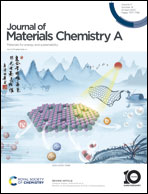Realization of high-performance room temperature solid state Li-metal batteries using a LiF/PVDF-HFP composite membrane for protecting an LATP ceramic electrolyte†
Abstract
The NASICON-type lithium aluminum titanium phosphate (LATP) solid-state electrolyte is considered as a promising candidate for next-generation lithium metal batteries with high energy density. However, the instability of LATP in the presence of Li metal and its poor contact with the electrodes hinder its practical application. Here, a novel protective-layer (PL) consisting of a PVDF-HFP polymer matrix and LiF ceramic particles was developed. The proposed layer provides a suitable interface between LATP and the electrodes, prevents the reduction of LATP by Li metal, and suppresses the growth of Li dendrites. The excellent performance of the PL|LATP|PL structure as a ceramic-polymer composite electrolyte (CPCE) was demonstrated by Li|CPCE|Li symmetric cell plating/stripping for 1000 hours at 0.5 mA cm−2 without a short circuit. In addition, the assembled LiFePO4|CPCE|Li full-cell was tested at two different C-rates of 0.2C and 1C. The cell cycled at 0.2C was durable and stable for about eight months and retained 86.4% of the initial capacity of 135.6 mA h g−1, while the other cell cycled at 1C had desirable cycling performance for 2000 cycles with little capacity degradation of about 12.5%. In this study, an efficient and robust composite electrolyte was proposed for the development of solid-state Li-metal batteries with high stability, long lifetime, and high power density.

- This article is part of the themed collection: #MyFirstJMCA


 Please wait while we load your content...
Please wait while we load your content...